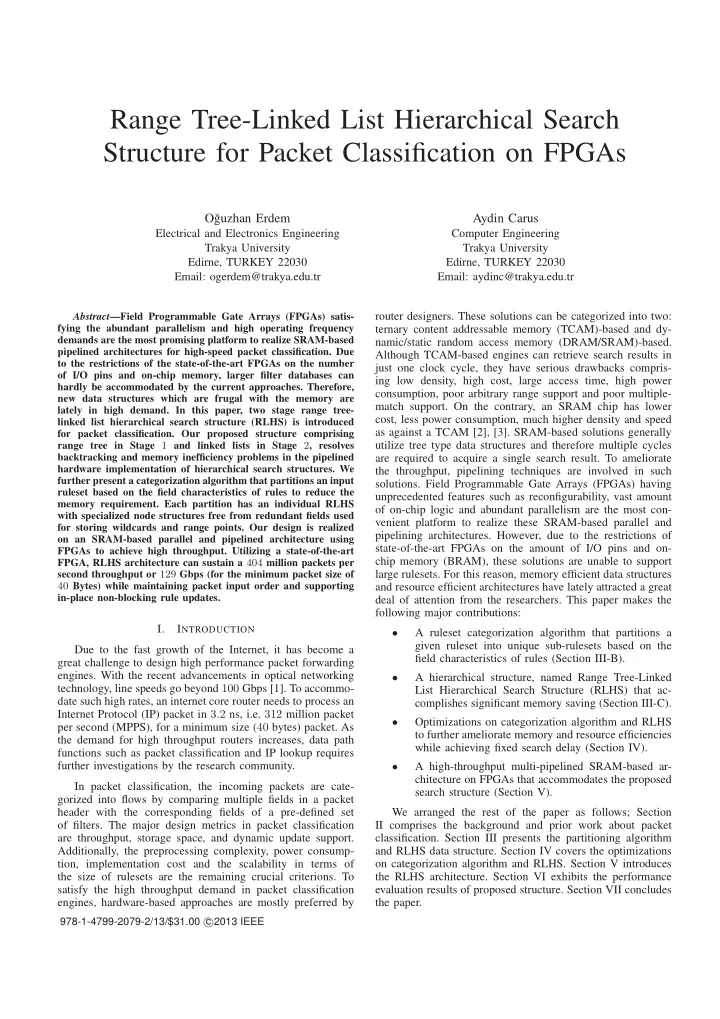

Range Tree-Linked List Hierarchical Search Structure for Packet Classification on FPGAs O˘ guzhan Erdem Aydin Carus Electrical and Electronics Engineering Computer Engineering Trakya University Trakya University Edirne, TURKEY 22030 Edirne, TURKEY 22030 Email: ogerdem@trakya.edu.tr Email: aydinc@trakya.edu.tr router designers. These solutions can be categorized into two: Abstract —Field Programmable Gate Arrays (FPGAs) satis- fying the abundant parallelism and high operating frequency ternary content addressable memory (TCAM)-based and dy- demands are the most promising platform to realize SRAM-based namic/static random access memory (DRAM/SRAM)-based. pipelined architectures for high-speed packet classification. Due Although TCAM-based engines can retrieve search results in to the restrictions of the state-of-the-art FPGAs on the number just one clock cycle, they have serious drawbacks compris- of I/O pins and on-chip memory, larger filter databases can ing low density, high cost, large access time, high power hardly be accommodated by the current approaches. Therefore, consumption, poor arbitrary range support and poor multiple- new data structures which are frugal with the memory are match support. On the contrary, an SRAM chip has lower lately in high demand. In this paper, two stage range tree- cost, less power consumption, much higher density and speed linked list hierarchical search structure (RLHS) is introduced as against a TCAM [2], [3]. SRAM-based solutions generally for packet classification. Our proposed structure comprising range tree in Stage 1 and linked lists in Stage 2 , resolves utilize tree type data structures and therefore multiple cycles backtracking and memory inefficiency problems in the pipelined are required to acquire a single search result. To ameliorate hardware implementation of hierarchical search structures. We the throughput, pipelining techniques are involved in such further present a categorization algorithm that partitions an input solutions. Field Programmable Gate Arrays (FPGAs) having ruleset based on the field characteristics of rules to reduce the unprecedented features such as reconfigurability, vast amount memory requirement. Each partition has an individual RLHS of on-chip logic and abundant parallelism are the most con- with specialized node structures free from redundant fields used venient platform to realize these SRAM-based parallel and for storing wildcards and range points. Our design is realized pipelining architectures. However, due to the restrictions of on an SRAM-based parallel and pipelined architecture using state-of-the-art FPGAs on the amount of I/O pins and on- FPGAs to achieve high throughput. Utilizing a state-of-the-art chip memory (BRAM), these solutions are unable to support FPGA, RLHS architecture can sustain a 404 million packets per large rulesets. For this reason, memory efficient data structures second throughput or 129 Gbps (for the minimum packet size of 40 Bytes) while maintaining packet input order and supporting and resource efficient architectures have lately attracted a great in-place non-blocking rule updates. deal of attention from the researchers. This paper makes the following major contributions: I. I NTRODUCTION • A ruleset categorization algorithm that partitions a given ruleset into unique sub-rulesets based on the Due to the fast growth of the Internet, it has become a field characteristics of rules (Section III-B). great challenge to design high performance packet forwarding engines. With the recent advancements in optical networking • A hierarchical structure, named Range Tree-Linked technology, line speeds go beyond 100 Gbps [1]. To accommo- List Hierarchical Search Structure (RLHS) that ac- date such high rates, an internet core router needs to process an complishes significant memory saving (Section III-C). Internet Protocol (IP) packet in 3 . 2 ns, i.e. 312 million packet • Optimizations on categorization algorithm and RLHS per second (MPPS), for a minimum size ( 40 bytes) packet. As to further ameliorate memory and resource efficiencies the demand for high throughput routers increases, data path while achieving fixed search delay (Section IV). functions such as packet classification and IP lookup requires further investigations by the research community. A high-throughput multi-pipelined SRAM-based ar- • chitecture on FPGAs that accommodates the proposed In packet classification, the incoming packets are cate- search structure (Section V). gorized into flows by comparing multiple fields in a packet header with the corresponding fields of a pre-defined set We arranged the rest of the paper as follows; Section of filters. The major design metrics in packet classification II comprises the background and prior work about packet are throughput, storage space, and dynamic update support. classification. Section III presents the partitioning algorithm Additionally, the preprocessing complexity, power consump- and RLHS data structure. Section IV covers the optimizations tion, implementation cost and the scalability in terms of on categorization algorithm and RLHS. Section V introduces the size of rulesets are the remaining crucial criterions. To the RLHS architecture. Section VI exhibits the performance satisfy the high throughput demand in packet classification evaluation results of proposed structure. Section VII concludes engines, hardware-based approaches are mostly preferred by the paper. 978-1-4799-2079-2/13/$31.00 c � 2013 IEEE
Recommend
More recommend